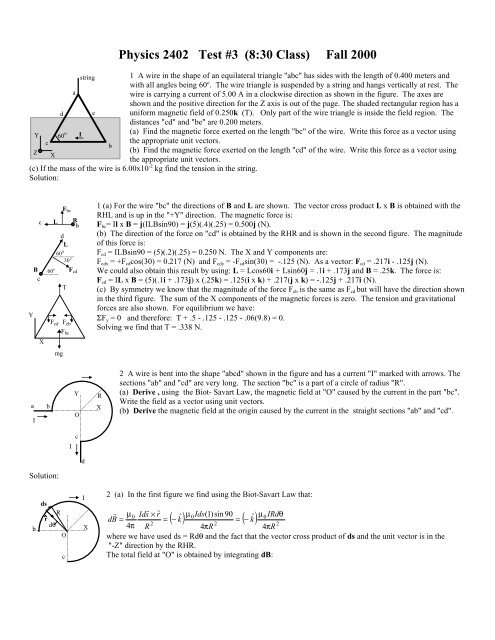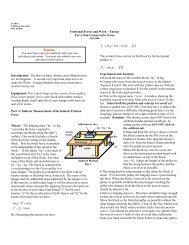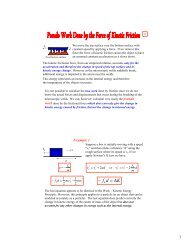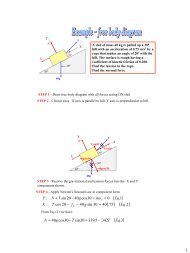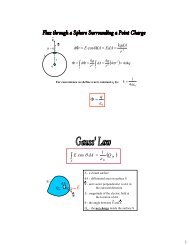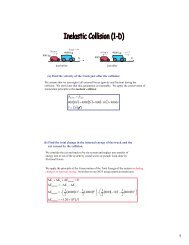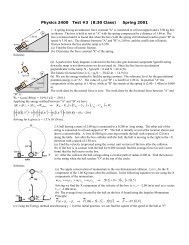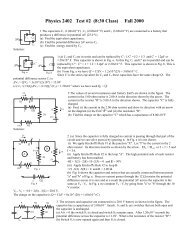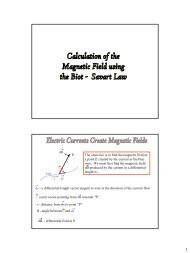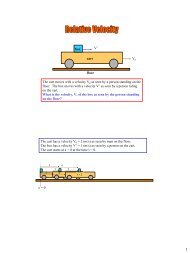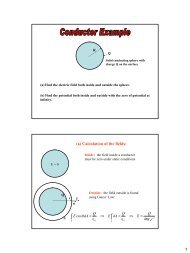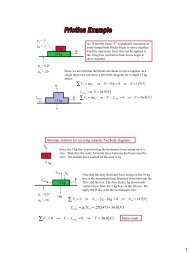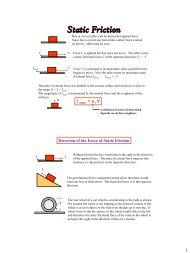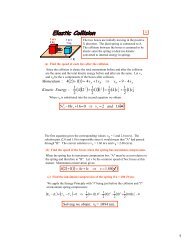Physics 2402 Test #3 (8:30 Class) Fall 2000
Physics 2402 Test #3 (8:30 Class) Fall 2000
Physics 2402 Test #3 (8:30 Class) Fall 2000
You also want an ePaper? Increase the reach of your titles
YUMPU automatically turns print PDFs into web optimized ePapers that Google loves.
Solution:(a) The charge is shown in Fig. 1 as it enters the magnetic field. The direction of the magnetic force must be in the negative Ydirection as shown for the charge to move along a quarter circle from "a" to "g". Since F = qv x B and the charge is negative the forceis in the direction opposite to the vector cross product v x B which therefore must be in the positive Y direction. By the RHR thedirection of B must be into the page ( in the -Z direction). Therefore we have: B = -0.200k (T).(b) For the circular motion from "a" to "g" the radial force is the magnetic force since it remains perpendicular tov x Bboth v and B. The magnitude of the magnetic force is:a v F = q vbsin 90F mApplying Newtons II Law to the motion we have:(c) From part (a) we know B is into the page. Using the RHR we find the direction of vxB to be in the +XYE direction as shown in Fig. 2. However the charge is negative so F m is in the opposite direction since F m = qvxB.vFor the charge to move in a straight line from "g" to "h" the net force must be zero by Newton's II Law. TheZ Xdirection of F e must be in the +X direction as shown.Fig. 2F qE qvB E vB (N∑ x = 0 ⇒ − sin 90 = 0 ⇒ = = 6.00 C )Since the charge is negative the force F e is in the direction opposite to the field which must be in the -Y direction. The field is: E = -6.00i (N/C).dB (X)FFig. 1IB(xxx)vxBcIRF eYabOX2mv mv mvF rad = ⇒ q vB = ⇒r= = 0.500( m)rr q B22 A wire "abcd" has two very long straight sections "ab" and "cd" and a quarter circle part "bc". The wire has acurrent "I" in the direction shown. The direction of the positive Z axis is out of the page.(a) Using the Biot-Savart Law, derive the magnetic field (in unit vector form) at the origin caused by the currentin "bc".(b) Using the Biot-Savart Law, derive the magnetic fields (in unit vector form) at the origin caused by thecurrents in "ab" and in "cd".Solution:Y (a) In the first figure we find using the Biot-Savart Law that:dsbrrRµ 0 Ids × r$ IdsrdB = = k$ µ 0 ( 1)sin9022dθ4πR4πRXc O where we have used ds = Rdθ and the fact that the vector cross product os ds and the unit vector is in the "+Z"direction by the RHR.The total field at "O" is obtained by integrating dB:πr2IB kR d k Ibc = $ µ 0∫ θ = $ µ 04π8R0(b) For the straight sections the angle between ds and the unit vector from ds towards "O" is zero or 180 degrees so the vector crossproduct of these two vectors is zero and the magnetic field is zero.c3 (a) Using Ampere's Law derive the magnitude of the magnetic field a perpendicular distance "r".from a long, straight wire that has a current "I".(b) In the figure the circles represent the cross sections of three very long straight wires "a" , "b"0.2 m0.2 mand "c" that are perpendicular to the page. They are located at the corners of an equilateral triangleof side 0.200 m and all of the angles are 60.0 degrees. Each wire has a current of 15.0 A. Thecurrents in wires "a" and "c" are directed out of the page and in wire "b" it is directed into theYpage. The "XY" plane is the plane of the page and the "+Z" direction is out of the page.a 60 b.0(i) Find the X and Y components of the total magnetic field at the location of wire "c" producedxZ X 0.2 mby the other wires "a" and "b".(ii) Find the magnetic force exerted on a 2.00 m length of wire "c" by the other wires. Write thisforce as a vector using the correct unit vectors.
NrFMFig. 2vq(b) As the charge moves from "M" to "N" the magnetic force is perpendicular to B (into page) and v. As a result themagnetic force causes the charge to move in a circular path of radius "r" . The magnitude of the magnetic force isqvbsin90. Applying Newton's II law gives:2 2mvmvFrad = qvBrr⇒ sin 90 = r⇒ =mvqBSolving we find that r = 0.500 m.(c) The speed is different so the path will not have the same radius found in (b). The time to go from "M" to "N" is the time to travelhalf way around a circle. The distance traveled is πr and the charge's speed is found from the same equation found in (b):qBrv =mThe time taken is:πrπm−T = = = 175 . × 10 2 ( s)v qBNotice that the time does not depend on the radius of the path. Therefore the slower moving charge takes the same time as the fastercharge of part (b).I"abcda".Solution:YR 2R 1b c O dIaX2 The wire "abcd" has a current "I" in the direction shown. The positive "Z" direction is out of thepage.(a) Using the Biot-Savart Law derive the magnetic field (in unit vector form) at the origin caused bythe current in the semicircular part "ab".(b) Using the Biot-Savart Law derive the magnetic field at the origin caused by the current in thestraight part "bc".(c) Find the field at the origin (in unit vector form) caused by the current in the complete loopdsrR 2dθdsθbr c Od2 (a) The figure show the vectors ds and the unit vector for the wire "cd". The magnitude of themagnetic field, dB, at the origin caused by the current in ds is:rrµ 0 Ids × rˆˆ µ 0Irdθsin 90 ˆ µ 0IR2dθdB = = − k= − k4π22R4πr4πR2( ) ( )22where we have used ds = R 2 dθ and the RHR to determine that the vector cross product is into the page in the negative "Z" direction.The total field at the origin is:r rˆπ⎛ µ 0I⎞ ˆ µ 0IB = ∫ dB = ⎜ − k dθ= −k4πR⎟∫⎝ 2 ⎠ 4R02(b) For the wire "bc" the angle between the unit vector and ds is zero so the magnitude of the vector cross product is zero and the fieldis zero.(c) The field due to ""dc" is in the positive "Z" direction by the RHR. The total field at the origin is:r ⎛ ⎞= ˆ µ 0I1 1B k⎜ −⎟4 ⎝ R1R2⎠3 (a) Using Ampere's Law derive the magnitude of the magnetic field a perpendicular distance "r" fromwire 2Ya long, straight wire that has a current "I".X d(b) The figure shows the end view of two very long parallel wires which are perpendicular to the pagesmooth and are at rest. Wire #1 has a current of 200 A out of the page while wire #2 has a current of 400 A intowire 1<strong>30</strong> 0 incline the page. Wire #2 is located on a smooth inclined surface that makes an angle of <strong>30</strong> 0 with the horizontal.The distance "d" between the two wires is 0.050 meters. Find the magnetic force that wire #1 exerts on a2.00 meter length of wire #2. Express this force as a vector with the proper unit vectors. The direction of the "X" and "Y" axes areshown and the positive "Z" direction is out of the page.(c) Find the mass of the 2.00 meter length of wire #2 mentioned in part (b).
Solution:B dsrIFig. 1C3 (a) Fig. 1 shows a path "C" of radius "r" surrounding the wire which is carrying a current "I" out of the page. Overthis path the magnetic field is tangent to it as shown. The vectors ds and B are parallel. Applying Ampere's Lawgives:r rµ 0I∫ B • ds = µ 0 I ⇒ B cos0∫ds = µ 0I⇒ B( 2πr)= µ 0I⇒ B =2πrCCWe have used the fact that B is a constant at a given radius and can be removed from the integral. Also the integral of "ds" aroundpath "C" is the circumfrence, 2πr, of the circle.(b) The first wire creates a magnetic field at the location of the second wire which has the magnitude:BYX.Fig. 2<strong>30</strong> 0L xF mF m = ILBsin90 = 400(2)(8x10 -4 ) = 0.640N.NFmgsin<strong>30</strong> m<strong>30</strong> 0 mgcos<strong>30</strong>mgFig. 3µ 0I1−4B = = 8.00 × 10 ( T )2 π dThe direction of this field is obtained by the RHR and is shown in Fig. 2. The vector L has a magnitude of2.00 m and is into the page as shown. The magnetic force on this 2.00 m length of wire 2 is: F m = IL x B.The magnitude of this force is:The direction of this force is obtained from the RHR and is shown in Fig. 2. The force is:F m = 0.640i (N).(c) The forces acting on wire # 2 are shown in Fig. 3. For equilibrium we have:Fm∑ Fx = 0 ⇒ Fm− mg sin <strong>30</strong> = 0 ⇒ m = = 0. 131( kg)g sin <strong>30</strong>


